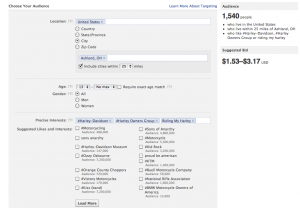Church advertising observations from someone who doesn’t like church advertising. Part two in a two part series. Read part 1, Why Church Advertising Doesn’t Work.
In my first article, I explained three reasons why most church advertising doesn’t work. I promised some practical action steps to design church advertising that reaches the people in your community.
Here are eight steps to attract people in your community in a compelling way:
 1. Identify people groups in your community based on their passions.
1. Identify people groups in your community based on their passions.
Most people in your community are not thinking about going to church. But what are they thinking about? What are they passionate about? What are they excited to pour their time into when they get home from work? Get a diverse group of people in your church to brainstorm… you will quickly come up with a dozen or more groups of people.
2. Who can your church most effectively reach?
Let’s be realistic. You can’t effectively reach all of these groups. The way you reach a Harley-Davidson fan is typically different from the way you reach a gardener. Your church is uniquely equipped to reach some of these groups very effectively. This has a lot to do with the personality of your church. Pick a few of these people groups that overlap with the people already attending your church, and/or the people you as a leader are passionate about attracting.
Before we continue, many churches have tried steps one and two, and then built outreach events accordingly. That’s why we often see church softball leagues, motorcycle rallies and Super Bowl parties. These activities are good, but they don’t usually speak to people at a deeply emotional level. As a result, you end up with the second best softball league, motorcycle rally, or Super Bowl party in town.
That’s why step three is so important. I don’t see churches doing this:
3. Learn what keeps these people up at night.
Do you want to reach your community at a deep level? Identify what keeps them up at night. What are those deeper emotions that drive them to obsess over their motorcycle, climbing a corporate ladder, or never-ending home improvement projects? What chronic problems do they deal with in their lives? These fears & problems will vary a bit from each group you identified in steps one and two. Sometimes it relates to the passion (e.g., parents worrying about their kids) but usually the thing they pour their time and passion into is just a facade for what keeps them up at night.
Step three may make you uncomfortable. I understand. But advertisers are capturing the hearts of consumers by speaking to them at a deeply emotional level. They tell them that the thing they are selling will make them happy. Advertisers do it in a manipulative and deceitful way way, but you can do it without manipulating or deceiving. Don’t lose sight of the fact that you are sharing the Gospel! You have something to share that will actually transform their lives!
4. Develop practical biblical teaching.
In step three you identified a chronic problem or fear that these groups of people face. What does the Bible say about this topic? If you’ve listed a problem or fear in step three that you don’t think the Bible addresses in a practical way, then you probably are still listing symptoms instead of root problems.
Pick one of these fears or problems. Prepare a multi-week teaching series, and make sure that each week offers its own practical action steps, as well as benefits for attending. Each part of the series should include specific action steps that will help them with the thing that keeps them up at night.
5. Don’t water it down.
It may be tempting to dilute your teaching to make it more more seeker-friendly. But if you hit on a problem that speaks to them at an emotional level, they want all the information they can get. Consider showing them the tip of the iceberg and point them toward additional resources through scripture, and trusted Christian authors. People who think scripture is irrelevant have probably never discovered that there are practical answers to the specific problem they face.
Now that the teaching is developed, it’s time to re-engage your advertising campaign! But your ads will no longer talk about your church. You are about to earn their attention in a compelling way.
 6. Design advertising that speaks to these people at an emotional level.
6. Design advertising that speaks to these people at an emotional level.
Focus on what keeps them up at night, and the practical outcomes of your teaching. Make a promise about what practical benefits they’ll get for taking action. By the way, your call to action should probably not start with visiting your church. We all know that’s a risky proposition for some. This leads to step seven.
 7. Create a marketing funnel.
7. Create a marketing funnel.
You need to create “baby steps” that people can take before they step foot in your church. Don’t require people to visit your church to start learning about solutions to their specific problem. Instead, earn their trust with some practical teaching on your website that will help them even if they never visit your church. This will help earn their trust and prove that you are a credible source of information. Yes, effective baby steps will get more people in the pews for your teaching series. But it will also get many more people interacting with you through your website, even if you don’t know who they are there. I will write more about how churches can use marketing funnels in a future article.
8. Make your advertising more targeted.
Billboards and direct mail are fine, but you should supplement them with more targeted forms of marketing. In steps one and two, you identified groups of people who have specific interests and passions.
Did you know that using Facebook you can advertise to these folks in a targeted way? For example, there are more than one million people in the U.S. who “like” Harley- Davidson on Facebook. And despite the rural community where I live, 1,540 of them are within driving distance of my church! You can run targeted, local Facebook ads that tie your message to their passions, and you only pay when someone clicks.
Thousands of ads are running at this very moment that suggest random products or activities will fill the void in consumers’ lives. The ads get results because they speak at a deeply emotional level. When we begin to understand this, it suddenly seems silly to run ads that differentiate your church from other churches.
To a small church on a shoestring budget, this idea can be daunting. “I’m competing against national ad agencies for the attention of local consumers… are you kidding me?” But take heart. You have the real answer to people’s problems. And that can make all the difference.
Photo by mtsofan





Pastor Speaking
October 2, 2012
This topic addresses the REAL-NESS or TRANSPARENCY that people are looking for from THE CHURCH. I feel when we say things that bring bad reflections on the church in efforts of marketing or branding we hurt the church (all churches) more than help the growth of the church “God’s Idea”!!! People want to believe in something! They want a place to belong. They want to trust the CHURCH but “man” has worked programs and schemes that have blurred the BASIC FOCUS of why God sent Jesus and that was to bring man back in relationship with him! Thanks for this refreshig series! I am extremely looking forward to sharing these tips with our leadership so that we STAY REAL & TOUCHABLE, and REACH where people with marketing ideas that build THE CHURCH as a whole !!! I mean after all….if they get saved at your place of worship or mine isn’t that the real mission?
Trees
October 2, 2012
Good points. Getting people to think “who is my audience” always seems so hard. I don’t strictly do marketing at my church but I occasionally help out. When I raise this question, the answer is almost something like, “Everyone!”
Yes, yes. The Church is for everyone but we can’t talk to everyone the same way, about the same thing, at the same time.
One of our pastors did a lengthy study of what brought new people to our church. One of the biggest reasons was challenging life situations such as job loss, divorce, or death of a loved one. This knowledge has helped us understand the “who” and the “why” and helps us guide the “how” of what ministry should look like for many new attendees, especially those that are hurting. This can definitely help with the “funnel” process of which you spoke.
Thanks for sharing and I look forward to more posts.
Rob Waugh
October 3, 2012
Thank you for a very insightful, heartfelt and equipping article. As a leader in our church, I am becoming increasingly passionate about how we market ourselves. In Australia, the church has a less than ideal reputation in part because of leadership failures particularly in the area of child molestation. We have a bad image, but the church is not, on any great scale, addressing this bad reputation with the far truer image of who we are and what we are doing to positively and eternally impact our communities and cities. Effective, honest, and heartfelt marketing from us can help shift things. You article empowers the right kind of marketing thinking for God-glorifying Gospel impact in this 21st century world. Thank you again!
Bryan Chalker
October 4, 2012
Terrific guide for keeping on-track. I especially like #2 and #3. Both address reaching them where they are. When that’s done, with a sincere heart and motivation (without coming off like the smarm-church who only wants numbers), then the church not only grows, but is strengthened.
Bob Cook
October 10, 2012
Over the spring and summer, my church, Pilgrim Faith United Church of Christ in Oak Lawn, Ill., tried something no other house of worship locally had tried: sponsorship youth baseball and softball teams. I wrote this piece for my Forbes blog about it in light of the Pew survey showing more people not identifying with organized religion:
http://www.forbes.com/sites/bobcook/2012/10/09/selling-religion-why-my-church-sponsored-youth-baseball-and-softball/
To sum it up, we spent $750 to get before thousands of parental eyeballs, two hours at a time, for four months. For mere exposure, that was a bargain, and for that reason, we may well do it again. However, what we’ve learned is that selling people on the idea of church — not just our church — is a difficult task.
In the Pew survey, 88 percent of those who were unaffiliated said they had no interest in seeking a house of worship at all. In our area, which is heavily Catholic, we see a chance to attract more of the people who make up our new members — people who have left that church, but didn’t want to leave church altogether. Your posts on advertising are a good guide to help ensure further communications from our church are targeted in the right ways, but what we’re realizing is that we’re speaking to a potential population that has soured on “church,” and doesn’t care to make denominational distinctions.
Sean
October 23, 2012
I’d like to say I LOVE this two part article. As an ad guy who is also a believer and trying to launch a Communications & Markting Ministry at my church, I found these articles not only helpful but inspirational. Something I try to keep top of mind is not to approach marketing for Christ/my church in the same way I would approach marketing for a product or service. Obviously, the significance of marketing for Christ is above all, and I think of it more as proclaiming the Good News of Christ more so than marketing. But. there are great principles in marketing, which you’ve spoken to here, that can be applied.